Difference between revisions of "Eriophyllum lanatum var. arachnoideum"
Man. Fl. Pl. Calif., 1119. 1925.
imported>Volume Importer |
imported>Volume Importer |
||
| Line 56: | Line 56: | ||
|publication year=1925 | |publication year=1925 | ||
|special status=Endemic | |special status=Endemic | ||
| − | |source xml=https:// | + | |source xml=https://bitbucket.org/aafc-mbb/fna-data-curation/src/2e0870ddd59836b60bcf96646a41e87ea5a5943a/coarse_grained_fna_xml/V19-20-21/V21_898.xml |
|tribe=Asteraceae tribe Heliantheae | |tribe=Asteraceae tribe Heliantheae | ||
|subtribe=Asteraceae (tribe Heliantheae) subtribe Baeriinae | |subtribe=Asteraceae (tribe Heliantheae) subtribe Baeriinae | ||
Latest revision as of 20:15, 5 November 2020
Perennials (clumped; ± taprooted or roots branched). Proximal leaves mostly alternate; blades rhombic to oblanceolate, pinnately lobed (usually in distal part of leaf, lobes 3–5, oblong or triangular), ultimate margins entire or dentate, revolute, abaxial faces loosely cobwebby-woolly, adaxial glabrate. Heads 2–4 per array or borne singly. Peduncles mostly 3–10 cm. Involucres 9–15 mm diam. Ray florets 8–15; laminae 8–10 mm. Cypselae (1.8–)2–3.2(–4) mm; pappi 0–0.2 mm. 2n = 16, 32.
Phenology: Flowering Apr–Jul.
Habitat: Ocean bluffs, inland sites, with conifers
Elevation: 0–700 m
Discussion
Variety arachnoideum merges with var. grandiflorum in coastal northern California, where intermediates with pappi to 1.3 mm may be found. Variety arachnoideum is morphologically similar to var. croceum; their distributions are disjunct.
Selected References
None.
